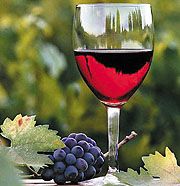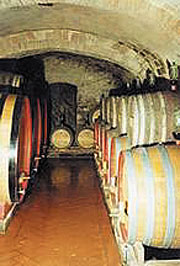Enjoy Bulgarian Wines!
According to historic and archeological
researches the territory presently occupied by the state of Bulgaria may
well be the first geographical region where vines were planted and wine
produced. The same area may claim property to the first vine protection
decree in 2 c. AD as well as to the first prohibitionist laws implemented
in history by the Bulgarian Chan Krum during his reign from 802 to 814
AD. The wine cellar may also be Bulgarian invention since Bulgarian monastic
orders had first been reported to have stored wine in cool vaults deep
under the ground level.
The earliest traces of the wine traditions
in Bulgaria go back 3,000 years.
As well as the historians the scientists
also believe that the Bulgarian wine cultures of today Pamid, Dimyat,
Misket, Gamza, Mavrud and thebroad vine of Melnik date back to Thracian
times.
It would be fair enough to assume that the
wines of this period would have probably tasted quick thick, sweet and
flavored, as this was how the ancient writers described them. It was also
common for consumers to add water to their wine at a ratio of 2:1, as
drinking wine ‘straight’ was considered uncouth. This type of consumption
of unblended wine was known as ‘Scythian drinking’.
During these ancient times the Greek historian
Xenophont describes a feast organized by the Thracian king Sevt (424 –410
BC) in which wine was served in animal horns as a ritual practice.
Archaeological digs have resulted in the
finding of numerous votive plates, decorated vessels and coins depicting
scenes of wine drinking in the lives of the Thracians. Probably the best-known
pieces are of Bulgarian gold and silver, which depict ritual wine drinking
situations with the god Dionysus.
The wine growing of the Balkans continued
with the arrival of the Romans within the peninsula. Historians claim
the eastern Black Sea Coast region was where white wine started to evolve.
It is probable that this was the period that saw the establishment of
the Pomorie and Nessebur wine production.
The Ottoman Empire ruled Bulgaria between
the 15th and 19th centuries. This proved to be a disastrous period for
wine making. However wine consumption within this period survived due
to the fact that it was considered to be a very important aspect of the
Christian traditions within the empire.
The French doctor and archaeologist P.Siege
who traveled across Bulgaria in 1829 commented specifically on the wines
of the regions of Sliven and Anhialo, which he compared to the quality
of the French ‘Grave’ wine.
During the late 1920’s and early 1930’s
the Bulgarian wine industry started to grow through the introduction of
the vine and wine cooperatives.
Most of the cooperative projects were built
through Austrian and other western European expertise. The average winery
capacity levels ranged from 500 to 1,500 tons.
Within the period where Bulgaria was behind
the "Iron Curtain" wine making was consolidated, monopolized,
and turned into a state industry. Its target market was restricted to
the "Eastern Block".
It wasn’t until the 60’s and 70’s (although
Bulgaria was still under communist rule) that the ‘mass’ production of
prestigious red varieties started to hit the international markets.
1989 saw a significant political change
in Bulgaria and towards the end of the 1990’s the state monopoly of the
wine industry ended. This resulted in all the wine cellars being privatized.
Bulgaria has more than 80 industrial wineries,
which currently have an output between 1,000 and 60,000 tons.
Bulgaria’s wine industry currently accounts
for 30% of aggregate farm exports to the European Union. Bulgarian wines
are sold in the UK, Ireland, Germany, the Netherlands, Scandinavia, the
USA, Japan, Poland, and the former Soviet Republics.
BULGARIAN WINE INDUSTRY
"The success story of the Eastern Block"
as called by R. Joseph, the editor of Wine magazine, Bulgaria is gaining
reputation as a producer of high quality affordable wines. Until 1990
the wine industry in Bulgaria was state-owned and was operated by Vinprom
and exported by its subsidiary Vinimpex. In the 80's import of American
and Australian know-how laid the ground for production of high quality
wines in Bulgaria. Coupled with centuries old traditions and enormous
natural potential this tendency bore fruit and Bulgarian wines are gaining
popularity among consumers in Western Europe, United States, Canada, and
even as far as China and Japan.
After the fall of the totalitarian states
in 1990 privatization of state owned companies and land restitution went
under way in Bulgaria. At first at slow pace it is now gaining speed especially
after UDF (Union of Democratic Forces) came into power in October, 1996.
The potential for wine making in Bulgaria
is enormous. The climate in the northern part of the country is continental
with cool winters and hot summers. It is milder to the south due to the
influence of the Black sea and the Mediterranean. Local hilly terrenes
create ideal micro-climates and combined with good quality soils they
produce extremely suitable conditions for growing best quality grapes.
The best wines are produced from the Merlot
and Cabernet Sauvignon varieties, high quality, rich, and Bordeaux-like.
Local grapes include:
Gamza - the most widespread sort produces
earthy, light bodied red wine good for simple fare. In Romania and Hungary
it is known as Kadarka.
Mavrud - is a full bodied, spicy red that
can age to more than 8 years.
Melnik - grown in the southernmost part
of the country makes hefty red wines that age very well.
Pamid - rustic and hardly unforgettable
but still good enough "commercial" for daily drinking.
Whites are produced from renowned varieties
such as Chardonnay, Sauvignon Blanc, and Riesling as well as from the
local: Misket, Ottonel, and Dimiat.
As still unpopular as it is, Bulgaria is
the second largest exporter of bottled wine in the world, second only
to France and it has four times the area, planted with Cabernet Sauvignon,
of California. It appears to be the fastest growing new-comer on the market.
Beware!
BULGARIAN WINE REGIONS
The Northern region spans the area between
the Danube River and the Balkan mountain range from North to South and
between the Dobrudzha Valley and the Yugoslav border from East to West
respectively. High quality wines are produced from a number of different
grapes, red as well as white.
The Eastern Region covers the territory
along the Black Sea coast between the Northern border with Romania and
the southernmost point on the sea coast where Bulgaria shoulders Turkey.
The wines from the Eastern region are made mostly from white grapes.
The Sub Balkan Region contains the kettles
at the Southern foot of the Balkan Mountain. These deep valleys produce
unique micro climates. The famous in Bulgaria Sungurlare Misket comes
from there as well as the excellent Sungurlare Eau deVie.
White wines from different grapes are local
specialty. Slavjantzi is a popular winery from this region.
The Southern Region includes the Thracian
Valley from the Balkan Range to the Greek border and boasts almost Mediterranean
climatic conditions particularly good for Cabernet Sauvignon and Merlot
production. The best Bulgarian variety grape-Mavrud grows in the Thracian
Valley. Reds coming from this region are superb. The South Western region
covers what is popularly known as Pirin Macedonia. The Struma Valley runs
along it and brings strong Mediterranean influence in terms of climate.
Fine Cabernets are produced there. The appellation of Melnik is home to
the Melnik variety. An aromatic and hefty wine that ages very well.
So I invite you do try a bottle or two.
If your local store does not carry Bulgarian wines you can do a Google
search for “Bulgarian Wine”. This will provide you with places where you
can purchase Bulgarian wines over the internet.
If you Google “Bulgarian Wine Tours” you
will find many places that offer vacation packages to the wine regions
in Bulgaria.
For you red wine lovers, when you go on
the wine tour in Bulgaria make sure you learn the song about red wines.
As we say in Bulgaria, Na Zdrave! “For Health”.
Daphne Karcheva-Orris



